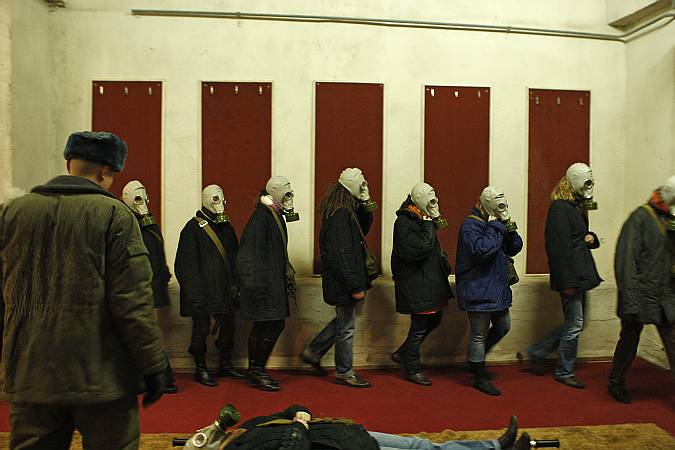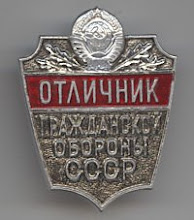
Tourists Don GP-5 Gas Masks to Relive the Soviet Experience
The tourists in the picture have donned GP-5 gas masks (Гражданской противогаз-5, lit. "civilian gas mask 5") and are circling around an "injured" comrade on a stretcher. The combination of gas masks and first aid was a common тренировка (drill) used by Soviet civil defense in its training activities. The GP-5 is probably the most common of the many civilian gas masks made in the Soviet Union, and is now widely available as a surplus item.In 1980, the Soviet government constructed an underground TV station near Vilnius, the capital of the Lithuanian SSR. Intended to be used in the aftermath of nuclear war, the facility has now been perverted to the ends of capitalism--that is, it is now a tourist attraction. For a mere $44, you can descend underground to eat Soviet food, listen to Soviet music, and be "interrogated" by the KGB. You'll also get to learn all about the the GP-5 gas mask, just like generations of Soviet people did in civil defense drills.
Gas mask training was the closest Soviet equivalent to the "duck and cover" drills found in the US in the 1950s. It was not, in fact, a product of the Cold War; they were something of an obsession dating back to the days of Osoaviakhim before WWII, and were merely continued from that era into the nuclear age. Beginning under Khrushchev the claim was made that gas masks like the GP-5 would help protect citizens from internal radionuclide expose following a nuclear attack, but Soviet civil defense was also convinced that NATO would also use biological and chemical weapons against the USSR. Therefore, the gas mask drills continued up until the end of the Soviet period, and became an ubiquitous part of every Soviet citizen's education.
While I was in Moscow this summer, I met with prominent Russian historian Elena Zubkova, who told me an anecdote about these gas mask drills. Just like almost every Russian I've met, Zubkova and her peers did not take civil defense training very seriously. Instead of paying attention to the instructor, she and her schoolmates kept twisting the air inlet on each others' gas masks, making it impossible to breathe. I gather that Soviet kids spent most of their time in these classes goofing off. Somehow I doubt this dimension of Soviet civil defense training is showcased in the totalitarian world portrayed by the underground TV station outside Vilnius, but who knows. I'm mainly just fascinated that these civil defense activities are now regarded as quintessentially "Soviet," at least it Lithuania.

No comments:
Post a Comment